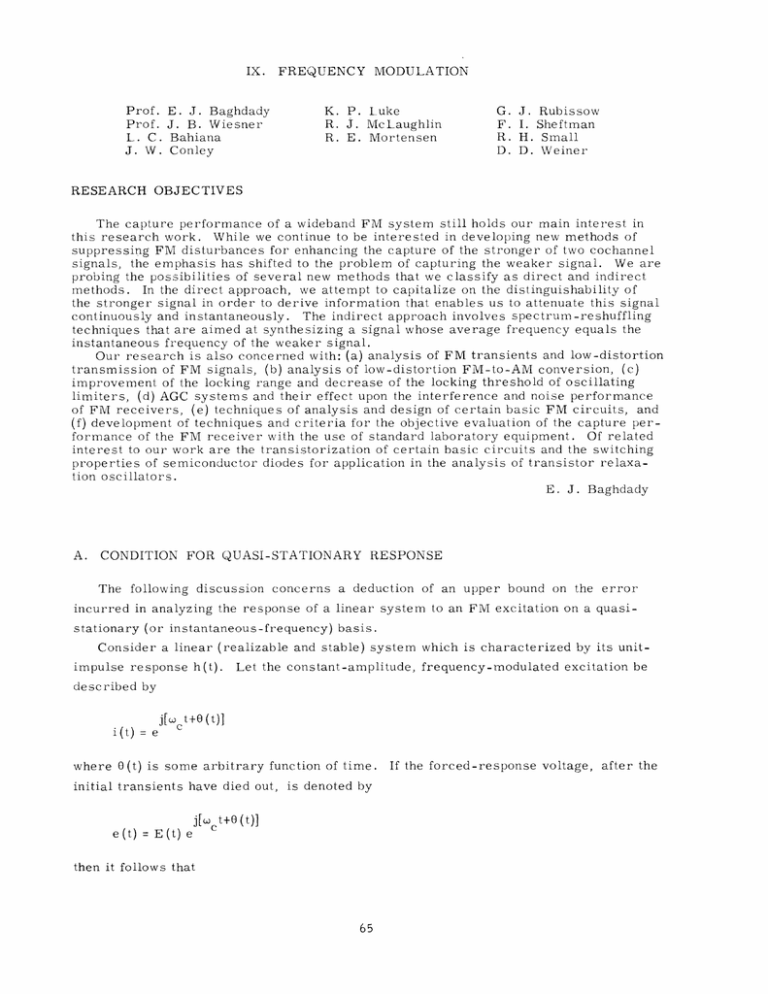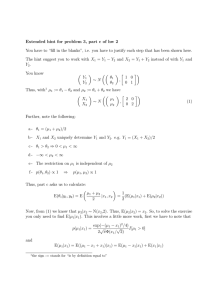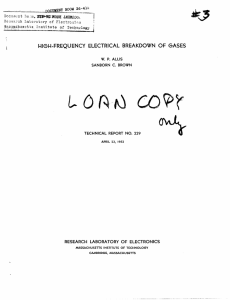IX. FREQUENCY MODULATION Prof. E. J. Baghdady
advertisement

IX.
Prof. E. J. Baghdady
Prof. J. B. Wiesner
L. C. Bahiana
J. W. Conley
FREQUENCY
MODULATION
K. P. Luke
R. J. McLaughlin
R. E. Mortensen
G.
F.
R.
D.
J. Rubissow
I. Sheftman
H. Small
D. Weiner
RESEARCH OBJECTIVES
The capture performance of a wideband FM system still holds our main interest in
this research work. While we continue to be interested in developing new methods of
suppressing FM disturbances for enhancing the capture of the stronger of two cochannel
signals, the emphasis has shifted to the problem of capturing the weaker signal. We are
probing the possibilities of several new methods that we classify as direct and indirect
methods. In the direct approach, we attempt to capitalize on the distinguishability of
the stronger signal in order to derive information that enables us to attenuate this signal
continuously and instantaneously. The indirect approach involves spectrum -reshuffling
techniques that are aimed at synthesizing a signal whose average frequency equals the
instantaneous frequency of the weaker signal.
Our research is also concerned with: (a) analysis of FM transients and low-distortion
transmission of FM signals, (b) analysis of low-distortion FM-to-AM conversion, (c)
improvement of the locking range and decrease of the locking threshold of oscillating
limiters, (d) AGC systems and their effect upon the interference and noise performance
of FM receivers, (e) techniques of analysis and design of certain basic FM circuits, and
(f) development of techniques and criteria for the objective evaluation of the capture performance of the FM receiver with the use of standard laboratory equipment. Of related
interest to our work are the transistorization of certain basic circuits and the switching
properties of semiconductor diodes for application in the analysis of transistor relaxation oscillators.
E. J. Baghdady
A.
CONDITION FOR QUASI-STATIONARY
RESPONSE
The following discussion concerns a deduction of an upper bound on the error
incurred in analyzing the response of a linear system to an FM excitation on a quasistationary (or instantaneous -frequency) basis.
Consider a linear (realizable and stable) system which is characterized by its unitimpulse response h(t).
Let the constant-amplitude, frequency-modulated excitation be
described by
i(t)
j[C ct+0 (t)]
= e
where 0(t) is some arbitrary function of time.
initial transients have died out, is denoted by
j[Wct+0 (t)]
e(t) = E(t) e
then it follows that
If the forced-response voltage,
after the
(IX.
FREQUENCY MODULATION)
C
-j
. T
g(t, T) h(T) e
E(t) =
dT
where oi(t), the instantaneous frequency of excitation, = w
ej[
g(t, T) =
(t-
T)-
+ dO/dt,
and
0(t)+TO'(t)]
If we assume that 0(t) and 0'(t) are continuous for all t,
and that 0"(t) exists for
0 < t < cc, then, by Taylor's formula, we have 0 (t - T) = 0(t) - TO'(t) + R 2 0 , where
,
210"(t - T)(< 1 < 1. It is evident that 10"(t - JT)
2wj
fore g(t, -) = exp(j R20) =1 + Rig, where R 1 g = j R 2 0 exp(j4R 20 ), 0
R2
20
R1 g
0 "(t)l max.
ax
< [ < 1, and
There-
R20 •
Thus we can write
[I + R 1 g] h(T) e
E(t) =
dT
0
+ R1E(t)
= Z(ji)
where Z(j i
1E
)
Rgh(T) exp(-j
dT.
Since
2
m
1<E"(t)
~j
2
and RE
d2 Z (j.)
1
R I (t)
i,
) d,)
h(T) exp(-J
(j i ) 2
max
ax d
d(jw
it is evident that E (t) is closely approximated by the quasi-stationary term,
Z (jwi),
provided that 0(t) satisfies the indicated restrictions; Z(s) is analytic in the right-half
of the s-plane and on the jw-axis; and
E =-
1
I0"(t)
2
max
Z"(i)«
Z(jw1 )
<< 1
If the maximum possible value of E is negligible compared with unity, this condition
will be satisfied at all times.
This maximum possible value occurs whenever
wi(')
is maximum, while wi(t) corresponds to the value at which
is maximum. We therefore require that
I(d/dt)
1 1Z"(ji
21
(t) max
E
Z(j)
max
Z"(ji)/Z(jwi)
q1
m
if the frequency of the excitation can be expected to sweep the frequencies at which
(IX.
FREQUENCY MODULATION)
Z"(j i)/Z (jwi) has its maxima. The quantity Em is then an upper bound on the relative error incurred in assuming that the forced response of the system is given by
e (t) = Z (jwi) exp
i(t
instantaneous frequency,
)
dt , where Z (jcwi) is the system function as a function of the
w., of the excitation.
It is interesting to note that the sluggishness of the filter is completely characterized
by
ZZ"(jc)/Z(jw)
the filter.
.
Thus we have chosen to call this ratio the "sluggishness ratio" of
Sluggishness-ratio plots, as well as a detailed discussion of low-distortion
transmission of FM signals through linear systems, based on the condition which has
just been derived, will be presented in Technical Report 332 (to be published).
An alternative expression for E(t) is given by
E(t) =
0
g(t,
) h(T)e
c
dT
where g(t, T) = exp[-jO(t)] exp[jO(t- T)].
Here, by using Taylor's formula, we have been
able to show that the error incurred in approximating E (t) by the first n terms of the
Carson and Fry expansion is dominated by the magnitude of the first rejected term in
this expansion.
E. J. Baghdady







